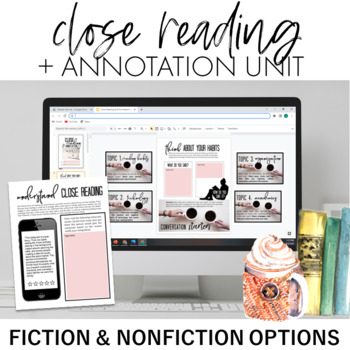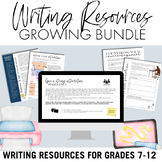Close Reading and Annotation Mini-Unit
- Zip
What educators are saying
Also included in
- If you are new to teaching AP Lang or your AP Lang curriculum needs an upgrade, this AP Lang Growing Curriculum Bundle is for you! I know if you’re reading this, you’re an AP Lang teacher who is looking for a curriculum that is engaging, 2020 AP Lang CED aligned, research-based, thorough, and effectPrice $100.00Original Price $124.00Save $24.00
- This growing bundle includes all of my writing resources at a 15% off discount versus buying them separately.A growing bundle means that as I finish new writing resources, I will add them to this bundle, and you will have automatic access to ALL updates for free just by re-downloading it from your pPrice $54.00Original Price $60.00Save $6.00
Description
Complete close reading and annotation unit with fiction and nonfiction practice
**August 2020 Update: This unit is now digital! I created a fiction and nonfiction workbook that is optimized for digital learning. A Google Slides version is included that can be downloaded and used as a PowerPoint as well (directions included).
**August 2019 Update: This unit now includes two passages that can be used for nonfiction annotation (complete with an answer key). This is perfect for AP Language and Composition as well as any nonfiction annotation practice.
Close reading is a lifelong skill, not a strategy. That can make it very challenging to teach. Thankfully, there are strategies we can use to improve students’ close reading skills. After years of research, I created this close reading and annotation mini-unit to teach students to apply their natural reading strategies for academic purposes. No more mindless highlighting, circling, and underlining!
This mini-unit will teach students to focus their close reading and annotate with purpose making their reading efficient and effective! It will take approximately 3 to 4 45-minute periods to complete. A suggested lesson guided is included.
This resource includes:
- "Think About Your Habits" Activity
- Conversation Starter Cards
- "Understand Close Reading" Activity
- "Identify the Purpose" Activity
- Reading Scenario Task Cards
- Find Your Active Reading Format Activity
- Reading Journal Example
- Annotated Poem Example
- Annotated Essay Example
- Annotated Speech Example
- Real-world connections
- Print in gray scale or color
- Close Reading Assignment Assessment*
- Editable PowerPoint assessment rubric
- Suggested answer key
- Teacher guide
*Please note the assessment rubric is the only editable component of this mini-unit.
You may also like my Scholarly Research Unit and my TALK to the Text Guided Annotation Bookmarks.





